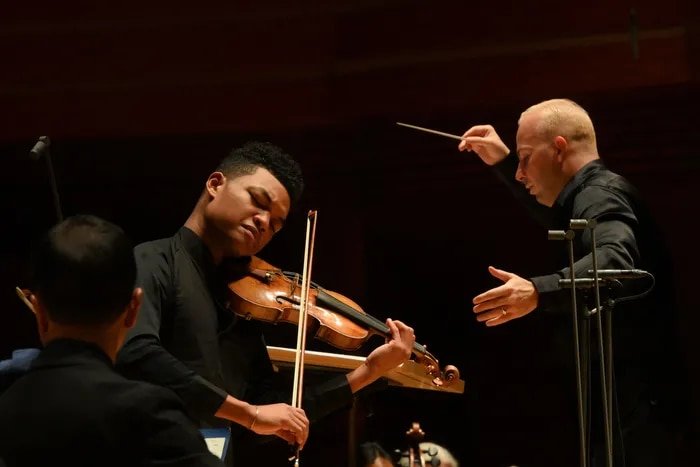Outstanding praise for Randall Goosby’s and Philadelphia Orchestra's Florence Price Violin Concerti Nos.1 and 2
Randall Goosby performing Florence Price Concerti Nos. 1 and 2 with Yannick Nezet-Seguin and the Philadelphia Orchestra on October 6, 2022 (Photo credit: Pete Checchia)
The reviews are in! Critics are praising Randall Goosby’s and Yannick Nézet-Séguin’s performances with The Philadelphia Orchestra of Florence Price Concerto Nos. 1 and 2 as “a perfect cap to an exploration of one of the 20th century’s most multifaceted composers.”
Bachtrack wrote….
Violinist Randall Goosby made a sensational debut with the Philadelphia Orchestra this past summer in Saratoga Springs, New York. For his first appearance on a subscription program at Verizon Hall, Goosby cleaved his considerable talent to the orchestra’s current passion project: the rediscovery and restoration of American composer Florence Price (1887-1953), who has become a touchstone of their repertory in just a few short years. The concert on 6th October featured world premieres of new editions of her First and Second Violin Concertos, which were recorded for future release by Deutsche Grammophon.
Written 13 years apart, the two works reflect Price’s culturally omnivorous composition style and wide range of musical influences. The Violin Concerto No. 1 emerges in a surprising stream of neoclassicism, its rippling cadenzas buoyed by echoes of American folk and roots music that carry across a fairly traditional three-movement structure. On first listen, I heard the influence of Dvořák – and not just because the Philadelphians played his Eighth Symphony so spectacularly last week. Like the Czech master, Price melds old world and new in an easily accessible yet endlessly complex musical language, sometimes messy but always engrossing.
Goosby impressed immediately with his fearless florid technique in the deceptively named first movement, Tempo moderato, which was actually quite fast in the hands of conductor Yannick Nézet-Séguin. At times, his sound mimicked a country fiddle, giving respect to Price’s Arkansas upbringing and her seamless melding of folk instruments into the fabric of the orchestral writing. The Andante was taken contemplatively before launching into the spirited Finale: Allegro, which suited Goosby’s plush tone with its richly chromatic writing.
Yannick Nézet-Séguin, Randall Goosby and the Philadelphia Orchestra (Photo credit: Pete Checchia)
Performed in one movement, the Violin Concerto No. 2 features a solo line that caresses the orchestra rather than fighting it. There is a full-bodied, distinctly American voice to the writing, which Goosby and Nézet-Séguin captured in their performance: Goosby’s playing in the higher register mirrored the transparent woodwind writing, which almost suggested wind blowing through an open field, before turning chestnut-dark as the strings joined in full blast. Nézet-Séguin skillfully balanced the multiple musical interplays of the piece, especially the spiritual-influenced duet between violin and trumpet.
Not content to leave the audience with these discoveries, Goosby and Nézet-Séguin returned to offer Price’s Adoration, transcribed for violin and string orchestra from its original organ setting. As traditional and tonal as her concerti were forward-looking, it proved a perfect cap to an exploration of one of the 20th century’s most multifaceted composers.
The Philadelphia Inquirer wrote:
Listeners will pat themselves on the back for detecting Tchaikovsky’s Violin Concerto woven into Price’s Violin Concerto No. 1 (1939). The resemblances are more than passing; they’re almost like quotes. She’s playing with us, the way Nino Rota referenced Mozart, Tchaikovsky, Brahms, and others in his piano concertos — with a knowing wink.
The main language, though, is unmistakably Price, an expression of Black American musical traditions wrapped in a feeling of ease that she alone owned. Goosby caught this aspect of the music’s character beautifully. There’s a golden glow around this piece, a sense of goodness in the world, for which the violinist and his deft virtuosity and pure sound were a perfect match.
Price’s short Violin Concerto No. 2 (1952) was more forceful, but still good-natured, and in single-movement form had particularly satisfying dialogue between orchestra and soloist.
Her Adoration (originally for organ) made for a lovely encore in Jim Gray’s arrangement for solo violin and strings. Goosby is not only technically impressive, but he also has those rare qualities of a first-class soloist: charisma for days, and the strong point of view of an artist with a distinct voice.


